Puppies have a lot of hyper energy and very short attention spans.
They are also infinitely curious and want to put everything that they see in their little mouths. This can make puppy obedience training something of a challenge.
When it comes to puppy training, we want to get our puppy to repeat good behaviors, and stop bad behaviors. The more a puppy practices a behavior, the more likely she will repeat it. Therefore, by encouraging good behaviors, we ensure that she will have a good repertoire of people friendly actions to draw upon when she grows up.
Here, we deal with the 3 primary elements of puppy obedience training –
- How to communicate consistently and effectively with a puppy.
- How to encourage good puppy behaviors.
- How to discourage bad puppy behaviors.

1. How to Communicate with Puppy

The first two words I teach my puppy are “Yes” and “No”.
“Yes” is used to mark a desirable behavior and “No” is used to mark an undesirable behavior.
Yes is usually followed by a positive consequence (e.g. a food reward, affection, toys), and No is usually followed by a negative consequence (e.g. withdrawal of attention, timeout).
In fact, we do not need to use the words “Yes” and “No”, and can pick whatever mark-words we want. The best mark-words are unique, and do not frequently come up in normal conversation. This helps to prevent confusion with our dogs.
For my dogs, I use Ack-Ack as a no-mark and Good-Boy or Good-Girl as a yes-mark.
- When my puppy does something good, I say “Good-Girl” and present her with a small treat reward.
- When my puppy does something bad, I say “Ack-Ack” and redirect her into doing something positive.
Consistency is very important while communicating with our dogs. We want to stick to the same yes-mark and no-mark.
In addition, we also want to establish very consistent rules and a fixed routine. This helps our puppy understand what is expected of her, as well as what she can expect from us.


One of the first things that I do with a new puppy, is set up a fixed routine. My puppy schedule includes playing time, training time, walking time, feeding time, and the ever important sleeping time. I try to keep the schedule consistent, so that each of these activities happen at around the same time every day.
Keeping a fixed schedule is good for me, and good for Puppy. It allows me to be more efficient about getting things done, and it sets aside some me-time while Puppy is sleeping and resting in her crate.
It also helps get a puppy accustomed to a new environment, without being overly stressed. In the beginning, everything is new, foreign, and possibly scary for a new dog. A fixed schedule helps to reduce stress, increase trust, and quickly integrates her into the existing family rhythm.
Similarly, a consistent set of rules will help to avoid confusion, and hasten the puppy learning process.
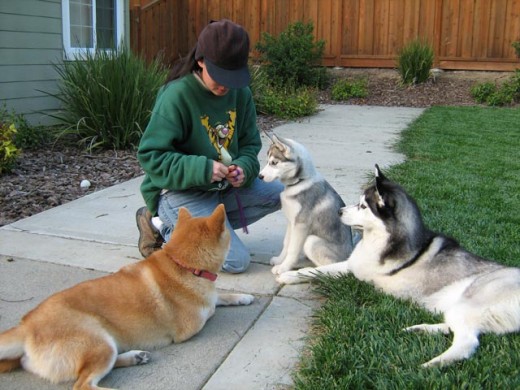
2. How to Encourage Good Behaviors
Puppy obedience training and even adult dog training is centered around two key areas-
- How to encourage and get puppy to repeat good behaviors.
- How to discourage and get puppy to stop bad behaviors.
It is important to recognize though that what we see as good and bad behaviors may not coincide with what our dog considers to be good and bad behaviors.
Dogs, even puppies, think for themselves and have needs of their own.
Therefore, we want to use our newly established communication system to teach our puppy what is good and bad for us. In addition, we must also motivate our dog so that she actually cares about our human values, which very likely, make little or no sense to her.


We encourage good behaviors by using the yes-mark, as soon as our dog finishes doing something good.
For example, when our puppy finishes doing a Sit we say “Good-Girl!” and then present her with a reward. The yes-mark is very helpful in training because it allows us to immediately mark the behavior that we want to reward.
To effectively train our puppy, we want to clearly indicate which action she is being rewarded for. If we wait too long, she will have moved on to something else, and we may inadvertently reward the wrong behavior.
Therefore, quickly use the yes-mark as soon as our dog finishes a good behavior. Then, we can take more time to present Puppy with her reward.

3. How to Stop Bad Behaviors
When it comes to stopping bad dog behaviors most of us think of applying a physical punishment, for example spanking the dog, jabbing the dog with our fingers, or giving the dog a collar correction.
These techniques apply pain to the dog, at which point the dog may stop her current behavior in order to avoid further pain and stress.
However, such pain based techniques are risky. If they are not executed with exactly the right force, timing, and redirection, they may cause more behavioral issues down the road; even aggression. It is especially risky to apply such techniques to puppies because of their young minds, and still developing bodies.
How then can we stop bad puppy behavior?

I have found that the best way to stop bad behavior is through the control of resources. *We* naturally control everything that a puppy wants, including food, toys, freedom, affection, and play.
To encourage good behaviors, we motivate our puppy by giving her something that she wants.
To discourage bad behaviors, we motivate our puppy by taking away something that she values, for example her freedom, or our attention and affection.
Note – This does not mean that we should tease our puppy and take away food while she is eating, or forcibly remove a toy that she is playing with. Doing so can encourage food aggression or resource guarding behavior.
What works best is to withhold something that my puppy wants, but does not yet have. Another possibility is to take away a privilege, such as withdrawing my attention or restricting her freedom.

When my puppy bites at my hands, I give her a no-mark (Ack-ack) and then redirect her to do something else, for example, chew on a toy. If Puppy redirects, I give her a yes-mark (Good-Girl), and reward her with something that she really wants, such as a yummy treat.
If Puppy ignores the no-mark and continues to bite at me, I withdraw my attention by standing up, folding up my arms, and turning away from her. In this way, she loses a valued play-mate, and no longer gets to engage in something fun.
If Puppy escalates her behavior and starts to jump on me or bite my clothes, I take away an even more important privilege; her freedom. I do this by calmly saying Timeout, and then taking my puppy to a boring but safe timeout area.
Puppies often bite at us to initiate play or to get our attention. We can effectively stop puppy biting by teaching her the following-
- Biting = No attention and no play,
- No biting = Attention, play, and treats.
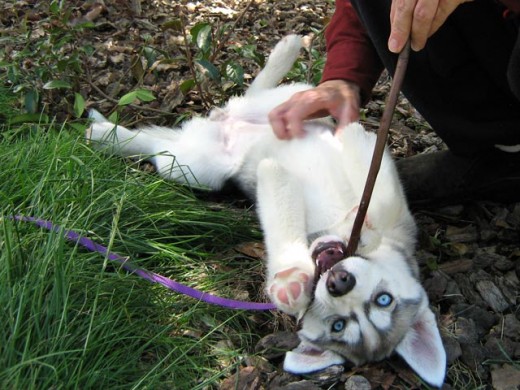
How to Train a Puppy
To stop bad behavior, I have found that it is important to –
- Start by redirecting Puppy into doing something positive. In this way, we turn a negative situation into a positive one. We not only get our dog to do what we want, but also teach her that following our commands, is the fastest way to get to her heart’s desires.
- Make the punishment suit the crime. I always start small and give my puppy many opportunities to choose a path for success. If she continues or escalates her bad behavior, then I slowly escalate her punishment.
- Stay calm at all times. Puppies have high energy and are easily distracted. If we get angry or frustrated, we will only inject more bad energy into an already volatile situation. This will likely cause our puppy to lose focus, become more hyper, and behave in an even more erratic fashion. If we want our dog to be calm, we must stay calm ourselves.
- Set Puppy up for success. Carefully manage our puppy and only expose her to situations that we think she can handle. For example, start by introducing her to new objects that are not moving, then slowly move on to moving objects, then objects that move and make noise, and so on. Start small and slowly move up to bigger things. The more successful a puppy is, the more confident she will become, and the more balanced she will be when she grows up.
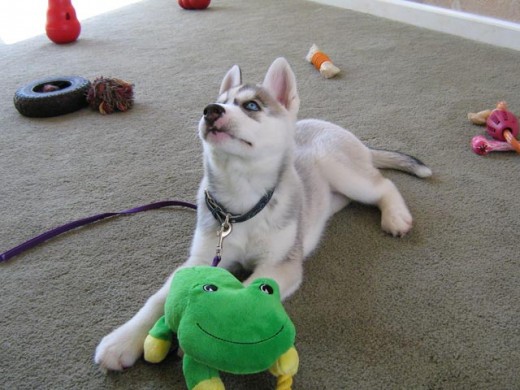
Goal of Puppy Obedience
The goal of puppy obedience is to learn how to communicate with our puppy, and teach her how to live well and harmoniously with us.
Obedience training can also help to protect our puppy from inadvertently harming herself and others, or from engaging in activities that may be detrimental to her health (e.g. over-eating, walking on glass).
Obedience training is *not* for acting out our anger, or venting our frustrations when our puppy poops on our furniture, eats poop, and spreads garbage all over our expensive designer couch.
We are not perfect, and Puppy is not perfect. In the initial stages, mistakes will be made, some of which may lead to chewed up designer shoes, scratched kitchen cabinets, and stained carpets. However, this is all part of the learning process.
Puppies, and indeed all dogs do not perform bad behaviors just to piss us off, make us angry, or exact revenge.
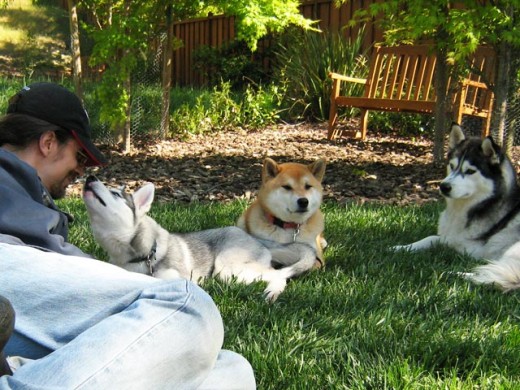
Puppies Acting Badly
Puppies or dogs act badly because …
- They do not know that something is bad because we did not teach them properly.
- They were stressed and started chewing, digging, or even pooping in order to relieve that stress (displacement behaviors).
- They felt threatened and thought it was necessary to protect themselves, or their belongings.
The key to puppy obedience training is in learning to see things from our dog’s point of view.
Once we understand what motivates our puppy, we can prevent undesirable actions and encourage desirable ones.
Dogs spend a lot of time observing us, understanding what makes us tick, and making us happy. The least that we can do, is try to return the favor.
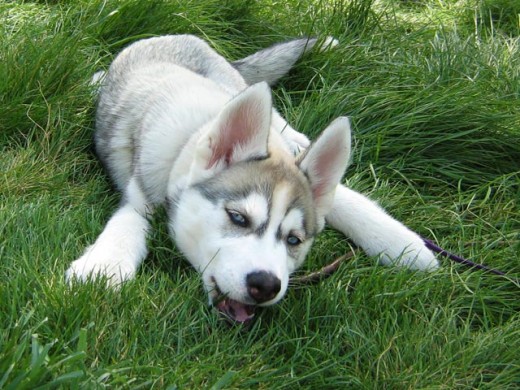
Hi I have a 1yr old siberian husky and she recently was being babysit while I was at work and Incountered a tragic accident and it resulted in her haveing her back left leg amputated . Well the problem is that since she has returned home from the vets she will pee outside but she WILL NOT poop outside anymore . I just don’t understand how she can go from completely potty trained to now not pooping outside at all even when I catch her right as she starts and take her out side she just will not go . But soon as I bring her in the house she try’s to poop .
What accident? Did it occur outside in the yard? Is she recovering well? Anything else outside that would make her uncomfortable/fearful? Sounds/smells? How long has it been since her amputation? Is it only grass outside? Is it mostly flat outside? Are there twigs, uneven ground, or anything else that may make it difficult to balance/squat on a single back leg?
Dogs are in a vulnerable position while pooping, so I have observed that my dog will only go in places where she feels totally safe and comfortable. Also, with a missing back leg, it may be more difficult to squat depending on the surface, especially while still healing. When my Husky was going through her surgeries and recovering, I let her go on puppy pads until she was feeling better.
http://shibashake.com/dog/dog-amputation-siberian-husky-shania
http://shibashake.com/dog/three-legged-dog-care-tripod-dog-care
Hi, I was considering to adopt a male puppy but i have a problem, I’m from Egypt and i can’t take my dog out and walk him, it will not be good for him in my area, but i can play with him in my house as long as he want, is that will be a problem with him and can i training him in the house and train him to pee in the bathroom ?
I really want Husky, but i’m afraid that i can’t make him happy or relieved
Please help me
Thank you
1. My Sibes do not do well in the heat. They get hot really quickly because of their thick double coats. For hot climates, I would look at breeds with shorter hair.
2. My Sibes enjoy being outside, they love going on hikes, and I walk them daily. We are out anywhere from 1-4 hours (part of it is resting and enjoying smells). 😀
There was one day when I skipped walking my younger Sibe, and she ended up digging her way to my neighbor’s yard. I also play with all of my dogs, we do obedience work, and more, but they still really need/want their walks. That is when they get to smell lots of interesting things, meet new people, etc.
3. My Sibes love to dig after rodents and other Earth critters. They both have high prey drive and will go after small animals or even larger ones, e.g. deer. Since the escape, I make sure my fence line is very secure and I put concrete blocks all around so that they can’t dig out.
Previously, when I didn’t have a yard, I picked a much smaller dog that is lower energy. High energy, larger dogs, are going to need more space and more exercise. Sibes generally love the outdoors and are high energy. After all, they were bred to pull sleds in very cold weather. 😀
Hi I am 17 and wanting my own husky now my aunt had explained about the things needed for caring for one and I am fully v aware and serious about one I an willing to try really hard to care for one and I wanted expert opinion on this.
Will you be going away to college soon? What will the dog’s home situation be like? What will the dog’s daily routine be like? Will there be any changes happening soon, e.g. new job? What is the context?
I have a 6 month old Siberian Husky puppy that I’ve had since he was 2 months old. We (my girlfriend and I) quickly learned that we need to set a routine for him and it has helped immensely for both us and him. He is generally well-behaved although he is VERY playful, which I don’t usually mind because he is still just a puppy and I enjoy playing with him. However, when we let him out to go potty (we have a fenced-in backyard) a lot of the time he won’t listen when we want him to come back inside. He will come up close to us and then when we reach out to grab him he takes off running. It is extremely frustrating because he knows what we want him to do, but he blatantly disobeys the command. It is increasingly becoming a bigger and bigger problem. He won’t come for food, treats, toys, anything. I try to give him the benefit of the doubt on days where we are busy and don’t have the time to play with him and walk him as much as we normally do, but we usually play outside with him for 30 mins to an hour and then walk him for another hour or two every day. Even then, he sometimes will still disobey the recall when we want him to come inside. I don’t want to punish him when he finally does come because I’ve heard that if you do he will not want to listen next time out of fear of being punished. The older he gets the more defiant he becomes in this area. Like I said, he is pretty well-behaved especially for a puppy. He doesn’t chew things (besides his toys) and is excellent on his leash, it’s just his recall that he seems to ignore when outside off-leash. Any tips on how to correct this behavior?
What usually happens after you call him inside? Does he go into his crate? Is it sleep time?
Dogs usually learn not to come because they associate coming, with an end to fun and play. Often, rewarding with just a toy or a treat will not work, because the reward is not strong enough to justify what must be given up, i.e. loss of freedom and fun. For this same reason, punishing a dog when he comes, will make things even worse, because not only is it an end to freedom, but he gets punished in addition.
I practice recall with my dog many times a day. When she comes, she gets rewarded with exceptionally good stuff and a fun game. Then, I let her go back to out if she wants. In this way, she associates “coming” with lots of positive rewards *and* no loss of freedom. I also make time inside the house be a lot of fun. I play with my dog inside, she get lots of affection inside, I prepare her food toys inside, and she only gets her food toys inside. Therefore, inside time to her is very awesome as well.
At night, I give her multiple great food toys to work on right before bed, filled with microwave chicken. This is something she doesn’t usually get during the day, so she is very happy to come in at night. The only exception is when she finds some animal outside, so in that case, I go outside and fetch her. In this way, recall always means come. If she doesn’t come, then she gets fetched anyway and misses out on the rewards.
Therefore, she learns that-
Coming when called = Lots of food toys, fun play session, and usually gets to go out again,
Not coming when called = No rewards, no fun, and get fetched anyway.
This ASPCA article has more on recall training-
http://www.aspca.org/pet-care/virtual-pet-behaviorist/dog-behavior/teaching-your-dog-come-when-called
“he knows what we want him to do, but he blatantly disobeys the command” – you
When did you teach your dog english??
You’re not training him right.
my daughter has just got a husky and ive been told they are really hard to train, is this true?
There are some things that can be a more difficult to train for a Husky. Both my Huskies have high prey drive, so their recall only goes so far. Leash training can also be more challenging because of the breed trait to pull.
I use reward/resource based training and that works well with my Huskies. More on Siberian Huskies.
Hi! I have a one year old husky named Thor, i love him and he loves to run! When i call him to come back he doesnt always come to me. I tried different treats but nothing works! Any advice????
This ASPCA article has a good list of recall training techniques-
http://www.aspca.org/pet-care/virtual-pet-behaviorist/dog-behavior/teaching-your-dog-come-when-called
Huskies usually have high prey drive though, and as you say, they love to run, so their recall is not always reliable. Big hugs to Thor! 😀
Hello we have a 1 year old husky names Beau. Hes generally a really good dog and knows most commands however the park i walk him at there is an enclosed pen where he can run free and interact with other dogs which he loves but when trying to recall him back he doesnt listen as other dogs are far more interesting that me any tips on how to make him return to me when needed. Thankyou!!!
Here is a good article from the ASPCA on a variety of recall training techniques-
http://www.aspca.org/pet-care/virtual-pet-behaviorist/dog-behavior/teaching-your-dog-come-when-called
However, the dog park situation is a very high level recall challenge because as you say, there are a lot of distractions and interesting playmates.
What I currently do with my dogs (at home) is to call them to me every so often during play. I make sure to reward them very well with high priority items, and then I let them go back to play.
In this way, they learn that –
Coming to me = get some great rewards, and then they can continue playing.
These “breaks” are also a useful way for me to manage their excitement level, by redirecting their focus back onto me and doing some quick commands to calm them down.
A common mistake that I made early on, is to call my dog to me when I am ready to leave, leash him up, and then go home. When I do that, my dog starts to associate me calling him with an end to fun and an end to play. Therefore, next time I call, he will probably not come because it signals an end to something that he really enjoys.
Hey! So we just got husky puppy and three days back and she is only 3months old. We are keeping her inside the house. She lives in my room and we have set a routine for her which she follows but the concerns I’m facing is that taking care of her and being with her is disrupting the whole house (we own two cats also) since someone or the other has to be with her. Plus we don’t have a crate for her right now so what would you suggest as an alternative? Another issue is that she gets ticks, maybe it’s cause when we take her outside to play or to poop. Given all these things, my mum is saying we should return her but me and my sister really want to keep her. Right now both of us are on holidays so we have all the time in the world but when they get over in a month and half it might get a bit challenging so within that time do you think we can get her trained enough so she adjusts almost perfectly?
Looking forward to your reply! Thank you!!
Siberian Huskies generally have high prey drive and a lot of energy. Both my Sibes need a fair amount of daily activity and structured/supervised exercise. Because of their high prey drive, I keep them on-leash when in non-enclosed spaces.
Here in more on Siberian Huskies.
Puppies require a lot more training and supervision, but I still spend a lot of daily time with my adult Huskies ~ for daily walks, grooming, training, etc.
My Sibes sometimes get ticks as well. I make sure to check them thoroughly after going out on trails or places where there may be ticks, especially during tick season.
More on ticks and other skin parasites.
That would depend on what you plan to use a crate for.
Hi
I got my first husky a week ago. I am constantly trying to train her. At 9 weeks old today she’s already managed to chew out of her run twice. Shes in a large run with two other dogs (labs) but she still seems keen to escape and seems very uninterested in her training.
Really need some help!!
Thanks
R
How are you trying to train her? What is her daily routine like? How much time does she spend in the run? Are the labs full grown? Is she supervised while out on the run? When puppy escapes, where does she go?
When I got Husky puppy Lara, she was very small compared to my two other dogs. Because of the big size difference, play can be risky and also scary for the small puppy. In the beginning, I supervised my dogs very closely, and still Lara got hurt when my Shiba (who is only about 32 pounds) accidentally ran over her. A small puppy cannot outrun adult dogs, and will often get rolled, and may get accidentally stepped on.
After that, I always had Lara on lead so that there is no running/chasing games. If I cannot be there, I put her temporarily in her crate or enclosure so that she stays safe. More on the first 10 days with my Husky puppy.
How is your puppy’s interaction with the two labs? She may be escaping to try and get out of their way.
Escaping is also a self reinforcing behavior. If a dog tries to escape and succeeds, then she is rewarded with a fun trip outside with lots of freedom. This reinforces the escaping behavior, which makes a dog more likely to keep trying it in the future.
When I get a new dog, I set up clear dog-to-dog interaction rules. I make sure that my puppy does not overly pester my adult dogs and similarly, that my adult dogs do not get too rough with my puppy. When Lara was still small, I keep her separated from my adult dogs, unless I am there to supervise and have her on-lead so that she cannot start a chasing game. I try to maximize positive, calm interactions while minimizing bad encounters.
More on how I introduce a new dog to my existing dogs.
Hi
I am training her with treats and attention when she does something good. When disciplining her I try to tell her off by saying no and sometimes a tap on the nose, but she never seems to pay attention and just thinks its be messing around with her.
Currently I get up at let her out and let her run around outside with the other dogs for about 45 minutes shes then goes into the large dog pen with the two labs. At the moment she gets let out at midday but this will eventually stop and she will be in there for the whole day. The labs are fully grown, and she was supervised at first but there isn’t someone around all day to keep an eye on her. When she escapes she just stays in the yard as there is no way for her to get out from there.
Generally she is supervised with the other dogs (we also have two dashhounds) none of the other dogs haven’t taken very kindly to her and snap at her over every thing shes does or try to avoid her entirely. At night she sleeps with the two dashhounds as we’ve heard the huskys like company & at night shes as good as gold.
She also cries a lot even when shes outside with the other dogs or even when by herself. She only stops when I go out to her.
Puppies generally have very short attention spans, so I motivate my puppy by keeping training sessions very short, fun, and extremely rewarding.
If the other dogs are snapping at her, the puppy may be escaping to get out of their way.
Both my Huskies love the company of people, and they also have a lot of energy. I make sure to provide them with enough people time and daily structured activity. More on the Siberian Husky temperament.
Hello!
I just got a 2 months husky and I need some basics training tips. this is my first husky and I’m not very familiar with the breed.
I’ll appreciate your help!
Congratulations on your new Husky puppy.
Some things that helped with my Husky Lara-
1. I set up a fixed routine and a consistent set of rules. I slowly teach my puppy what the rules are and I motivate her to follow rules by following the Nothing in Life is Free program.
2. I make sure to include a lot of positive structured activity in her daily routine. Puppy Lara had a lot of energy, so I had to direct that energy into good activities.
3. I also spent a bunch of time desensitizing Lara to grooming, e.g. fur brushing and teeth brushing. Huskies have a lot of fur, so getting them comfortable with brushing is a very good thing. 😀
4. I also did bite inhibition training with Lara, to teach her to control the force of her bites.
5. One big mistake that I made with Lara was that I did not socialize her enough. As a result, she is now somewhat reactive to people and other dogs. If I could do it over again, I would try to socialize her a lot more, in a positive and structured way. Here is more on dog socialization.
I write more about my training experiences here-
http://shibashake.com/dog-training
Big hugs to your Husky puppy!